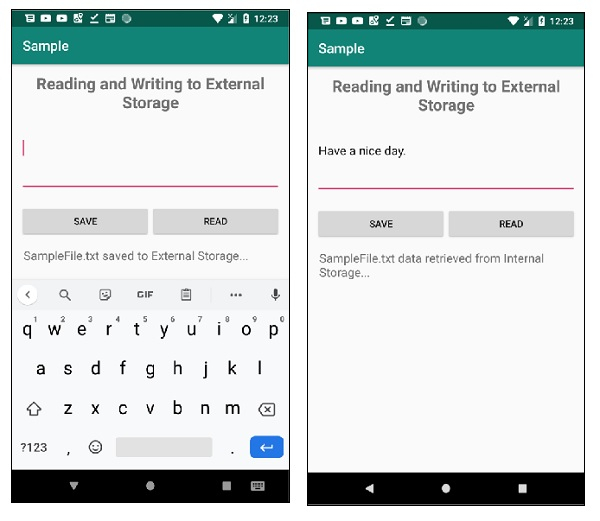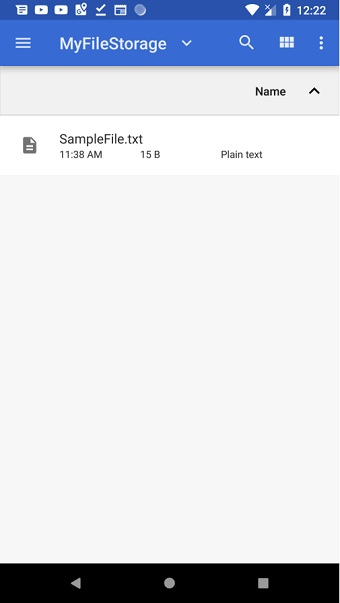
 Data Structure
Data Structure Networking
Networking RDBMS
RDBMS Operating System
Operating System Java
Java MS Excel
MS Excel iOS
iOS HTML
HTML CSS
CSS Android
Android Python
Python C Programming
C Programming C++
C++ C#
C# MongoDB
MongoDB MySQL
MySQL Javascript
Javascript PHP
PHP
- Selected Reading
- UPSC IAS Exams Notes
- Developer's Best Practices
- Questions and Answers
- Effective Resume Writing
- HR Interview Questions
- Computer Glossary
- Who is Who
How to set the Android permission on a folder/file on SD Card to be able to write to it?
This example demonstrates how do I set the Android permission on a folder/file on SD Card to be able to write to it.
Step 1 − Create a new project in Android Studio, go to File ⇒ New Project and fill all required details to create a new project.
Step 2 − Add the following code to res/layout/activity_main.xml.
<?xml version="1.0" encoding="utf-8"?> <LinearLayout xmlns:android="http://schemas.android.com/apk/res/android" xmlns:tools="http://schemas.android.com/tools" android:layout_width="match_parent" android:layout_height="match_parent" android:orientation="vertical" android:padding="12dp" tools:context=".MainActivity"> <TextView android:textStyle="bold" android:textAlignment="center" android:layout_width="match_parent" android:layout_height="wrap_content" android:text="Reading and Writing to External Storage" android:textSize="24sp" /> <EditText android:layout_marginTop="30dp" android:id="@+id/myInputText" android:layout_width="match_parent" android:layout_height="wrap_content" android:ems="10" android:gravity="top|start" android:lines="5" android:minLines="3"> </EditText> <LinearLayout android:layout_width="match_parent" android:layout_height="wrap_content" android:layout_marginTop="20dp" android:orientation="horizontal" android:weightSum="1.0"> <Button android:id="@+id/saveExternalStorage" android:layout_width="match_parent" android:layout_height="wrap_content" android:layout_weight="0.5" android:text="SAVE" /> <Button android:id="@+id/getExternalStorage" android:layout_width="match_parent" android:layout_height="wrap_content" android:layout_weight="0.5" android:text="READ" /> </LinearLayout> <TextView android:layout_marginTop="10dp" android:id="@+id/response" android:layout_width="wrap_content" android:layout_height="wrap_content" android:padding="5dp" android:text="" android:textAppearance="?android:attr/textAppearanceMedium" /> </LinearLayout>
Step 3 − Add the following code to src/MainActivity.java
import androidx.appcompat.app.AppCompatActivity;
import android.os.Bundle;
import android.os.Environment;
import android.view.View;
import android.widget.Button;
import android.widget.EditText;
import android.widget.TextView;
import java.io.BufferedReader;
import java.io.DataInputStream;
import java.io.File;
import java.io.FileInputStream;
import java.io.FileOutputStream;
import java.io.IOException;
import java.io.InputStreamReader;
public class MainActivity extends AppCompatActivity {
EditText editText;
TextView textView;
Button saveButton, readButton;
File myExternalFile;
String myData = "";
@Override
protected void onCreate(Bundle savedInstanceState) {
super.onCreate(savedInstanceState);
setContentView(R.layout.activity_main);
editText = findViewById(R.id.myInputText);
textView = findViewById(R.id.response);
saveButton = findViewById(R.id.saveExternalStorage);
saveButton.setOnClickListener(new View.OnClickListener() {
@Override
public void onClick(View v) {
try {
FileOutputStream fos = new FileOutputStream(myExternalFile);
fos.write(editText.getText().toString().getBytes());
fos.close();
}
catch (IOException e) {
e.printStackTrace();
}
editText.setText("");
textView.setText("SampleFile.txt saved to External Storage...");
}
});
readButton = findViewById(R.id.getExternalStorage);
readButton.setOnClickListener(new View.OnClickListener() {
@Override
public void onClick(View v) {
try {
FileInputStream fis = new FileInputStream(myExternalFile);
DataInputStream in = new DataInputStream(fis);
BufferedReader br = new BufferedReader(new InputStreamReader(in));
String strLine;
while ((strLine = br.readLine()) != null) {
myData = myData + strLine;
}
in.close();
}
catch (IOException e) {
e.printStackTrace();
}
editText.setText(myData);
textView.setText("SampleFile.txt data retrieved from Internal Storage...");
}
});
if (!isExternalStorageAvailable() || isExternalStorageReadOnly()) {
saveButton.setEnabled(false);
}
else {
String fileName = "SampleFile.txt";
String filePath = "MyFolder";
myExternalFile = new File(getExternalFilesDir(filePath), fileName);
}
}
private static boolean isExternalStorageReadOnly() {
String extStorageState = Environment.getExternalStorageState();
return Environment.MEDIA_MOUNTED_READ_ONLY.equals(extStorageState);
}
private static boolean isExternalStorageAvailable() {
String extStorageState = Environment.getExternalStorageState();
return Environment.MEDIA_MOUNTED.equals(extStorageState);
}
}
Step 4 − Add the following code to androidManifest.xml
<?xml version="1.0" encoding="utf-8"?> <manifest xmlns:android="http://schemas.android.com/apk/res/android" package="app.com.sample"> <uses-permission android:name="android.permission.WRITE_EXTERNAL_STORAGE"/> <uses-permission android:name="android.permission.READ_EXTERNAL_STORAGE"/> <application android:allowBackup="true" android:icon="@mipmap/ic_launcher" android:label="@string/app_name" android:roundIcon="@mipmap/ic_launcher_round" android:supportsRtl="true" android:theme="@style/AppTheme"> <activity android:name=".MainActivity"> <intent-filter> <action android:name="android.intent.action.MAIN" /> <category android:name="android.intent.category.LAUNCHER" /> </intent-filter> </activity> </application> </manifest>
Let's try to run your application. I assume you have connected your actual Android Mobile device with your computer. To run the app from the android studio, open one of your project's activity files and click Run ![]() icon from the toolbar. Select your mobile device as an option and then check your mobile device which will display your default screen −
icon from the toolbar. Select your mobile device as an option and then check your mobile device which will display your default screen −


Click here to download the project code.

